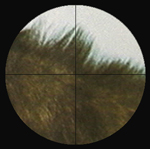| |
|
|
|
Features and benefits
- The SandyGrendel Design System is modular, every part is
easily
exchangeable.
- Light weight pure Titanium frame, hypo-allergenic, non-corrosive.
- Integrated protective screen (Pat.) made out of polycarbonate (UV 385 nm) can be removed within seconds.
- The SandyGrendel SG 2.5x/3.3x telescopic magnifying units are
light weight, small size, elegant, attached to the protective
shield and fully adjustable to IPD.
The loupes are made out of precision ground mineral glass and aluminum,
no plastic!
- SandyGrendel Design Surgical Telescopes are washable under running water.
- Your prescription lenses (if necessary) are well protected from splashes and debris during medical procedures, furthermore they are
detachable in no time at all (this is important if you also wear contact lenses alternately).
- The fiberoptic cable can be easily attached to the shield.
- The nose pads are welded to the frame to ensure optimal fit for all nose shapes.
|
|
As a result
- Titanium-Pro has an outstanding design which combines pleasing aesthetics with the highest level of functionality.
- Titanium-Pro provides superior wearing comfort due to innovative design features and high frame flexibility. The extreme light weight ensures a perfect fit at any head position. Retaining bands are unnecessary
and a feature of the past.
- Titanium-Pro frame + protective screen + magnifying units SG 2.5x = 1.2 oz. (36g).
- Due to small telescope size the view is not reduced and surrounding field control
is ensured.
- Titanium-Pro does not interfere with surgical masks, as they fit precisely between protective screen and nose pads without obstruction to wear and comfort.
- Titanium-Pro can easily be cleaned and disinfected.
- If new prescription glasses are needed, every optician is able to exchange the lenses. The loupes are not affected.
|
 top top
|
|
|
|
A first user mostly believes: The more magnification the better.
Fact is: "As much magnification as necessary, as little
magnification as possible." just about sums it up correctly.
(H. Gottlob,Product Manager, Carl Zeiss, Germany).
.
The higher the magnification,
- the smaller becomes the field of view (a decrease by the
power of 2).
- you will have not a large enough field of view for accurate
aesthetic dentistry that requires a diameter of ~2.5 inches, as
one has to refer to the neighbouring teeth. .
- the depth of field sharpness becomes narrower (decrease by
the power of 2).
- the margin of your working distance gets smaller (decrease
by the power of 2), luminous intensity decreases.
- observance of the surrounding field (visual monitoring of
the patient) becomes more difficult.
- head movement is more irritating because even small
movements quickly have you sight out of range and field of view.
Physical laws apply to all manufacturers of optical instruments all manufacturers of optical instruments.
|
|
According to our extended experience and feedback from our
customers a magnification factor of 2x or 3x is sufficient for most
dental procedures and needs of the dentist considering all relevant
factors.
In the final analysis 2 important advantages emerge when
operating with telescopes:
- The working distance (distance from the eye of the dentist to the mouth of the patient) must be kept relatively constant. This leads to a better posture.
- The muscles of the eyes are not stressed by an incessant near-accommodation. The result is a fatigue
induced, poor work.
|
|


The maximum possible enlargement and the optimal relevant
magnification are two different things!
|
 top top
|
|
|
| |
Use of magnification devices (or any optically ground lens, for that matter) will not adversely affect vision in the short or long term. Some people will initially experience some post-use blurring, eyestrain, or headache, but this
should only occur in the beginning after initial use and not persist
if at all for more than a few days. Your visual perception will
adapt to the magnification change.
If long term problems persist, return to your prescribing doctor
for a checkup. Surgical telescopes have been used for the last 30 years by dentists, ophthalmologist, neurosurgeons, plastic and vascular surgeons!
To date, there are no known adverse effects from any form of surgical magnification. |
|
 top top
|
|
|
|
There is no reason contact lenses cannot be used during surgery.
However, the eye must be protected at all times against foreign
matter and splashes. If contacts are used, safety lenses (with or
without telescopes) are mandatory. Careful consideration must be
given to adequate cleaning and disinfection of contact lenses and
this should be discussed with your prescribing doctor. |
 top top
|
|
|
|
Surgical magnification can be used at any age and is now readily available to dentists and surgeons in training.
The magnification effect enables work to be done more comfortably and effectively, it is
therefore worthwhile to start
as soon as possible. |
 top top
|
|
|
|
Please
download PDF file to find the
right solution for your prescription. |
 top top
|
|
|
|
Is there any need to sterilize or disinfect telescopes at all? The
surgical telescopes used in medical microsurgery are seldom if ever
sterilized or disinfected, nor is other sensitive equipment if not a
risk in the operative field. In order to protect telescope
performance, the MINIMUM CLEANING AND DISINFECTION CONSISTENT WITH
GOOD SURGICAL PRACTICE should be employed. |
 top top
|
|
|
|
The most important advantage of a coaxial headlight is to always have the light at the right spot - wherever you are looking, a tremendous
advantage to perform accurate and precise work! The headlight will
produce enhanced illumination of the actual work area e.g. oral
cavity or other operating areas. |
 top top
|
|
|
We recommend the SandyGrendel SwissLed
headlight
the advantages are:
High capacity output (~20'000 lux at 350mm distance for 4 hrs.
continuous use).
Precision focused LED light, no glare for patient.
Efficient electronically controlled power supply prevents heat
development.
Colour temperature is 6050 degrees Kelvin, similar to daylight
values.
Operable with battery pack or 110V adapter.
LED light is horizontally and vertically adjustable.
Yellow filter available to prevent premature curing of
composites.
Power supply box is small and light in weight, fits easily in
coat pocket.
Standard rechargeable Ni metal batteries are easily available.
Headlight is small, light weight and easy to keep clean.
Available with universal or SandyGrendel Ti-Pro adapter.
Weight including adapter is less than 28g (1 oz.)
alternatives are:
- Xenon lightsource with fiberoptic headlight
Xenon lamps produce a cold and blue light, they run on high voltage.
Xenon lamps can not be dimmed, but the output power can be
reduced with an iris.
Exchange bulbs cost around US$ 500.00 and should work up to 6000 hrs.
However, the manufacturers grant only three months warranty on
the bulb (~480 hours if the lamp is running
8h a day, 5 days a week).
- Halogen lightsource with a fiberoptic headlight
It has a warm color and low voltage and an electronic dimming
feature. Lamp exchange is easy and economical. Replacement bulbs
are very reasonably priced at approx. $ 8.00. Heavy use requires
5-10 bulbs/year.
|
 top top
|
|
|
|
Our loupes are marked with a specific working distance in milimeters.
If the loupes distance does not match with your personal focal
distance you may need a prescription for your eyes. The working
distance of our loupes can be changed easily by replacing the
cylinders to another distance. We have several standard focal
distances available. Please watch
Instructional Video Clip. |
 top top
|

